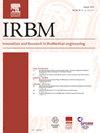Comparison of Different Sensor Locations on Freezing-of-Gait Ratio Results
IF 5.6
4区 医学
Q1 ENGINEERING, BIOMEDICAL
引用次数: 0
Abstract
Background
Freezing of gait (FoG) is a walking disturbance in the Parkinson's disease (PD). The freezing ratio (FoG-ratio) is a parameter used to quantify overall freezing severity rather than to assess single freezing episodes. Originally the FoG-ratio was designed to be computed from lower limb acceleration. However, some available measurement systems get their data from a single sensor located elsewhere, e.g. on the lower back.
Purpose
The objective of our paper is to analyse whether acceleration signals measured on different body locations result in a consistent FoG-ratio.
Methods
Eighty-four people with PD and 65 people without neurological disorders completed an instrumented Timed Up&Go Test (iTUG) twice. The FoG-ratios from inertial units placed on the chest, lower back, left and right lower limbs were calculated.
Findings
There were significant differences between the tested FoG-ratios in the control group as well as in the PD group for both segments. Four significant, but not consistent, correlations were revealed for the turn segment in the PD group. Eight correlations were revealed in the control group. The inter-trial reliability of all the tested cases for gait was good (rho>0.75) but only in one case for turning.
Conclusion
In conclusion, the placement of sensors affected the FoG-ratio parameter output. The different FoG-ratios reflect different amounts of power in the locomotion band of body segments. This could result in inconclusive validity and incomparability of freezing severity presented in studies when the sensor is placed somewhere other than on the lower limbs.

不同传感器位置对步态冻结率结果的比较
步态冻结(FoG)是帕金森病(PD)的一种行走障碍。冻结率(FoG-ratio)是一个用于量化整体冻结严重程度的参数,而不是评估单个冻结事件。最初设计的fog比率是根据下肢加速度计算的。然而,一些可用的测量系统从位于其他地方的单个传感器获得数据,例如在背部下部。本文的目的是分析在不同身体位置测量的加速度信号是否会产生一致的加速度加速度比。方法84例PD患者和65例非神经系统疾病患者分别进行了2次仪器定时起跳测试(iTUG)。计算了放置在胸部、下背部、左下肢和右下肢的惯性单元的fog -ratio。结果:在对照组和PD组的两个节段测试的fogg比率之间存在显著差异。PD组的转弯节段有四个显著但不一致的相关性。对照组有8项相关。所有测试病例的步态试验间信度都很好(rho>0.75),但只有一个病例的转弯试验间信度良好。结论传感器的放置位置影响FoG-ratio参数输出。不同的fog -ratio反映了身体各节段运动带的不同功率量。当传感器放置在下肢以外的其他地方时,这可能导致研究中提出的冻结严重程度的不确定性有效性和不可比较性。
本文章由计算机程序翻译,如有差异,请以英文原文为准。
求助全文
约1分钟内获得全文
求助全文
来源期刊

Irbm
ENGINEERING, BIOMEDICAL-
CiteScore
10.30
自引率
4.20%
发文量
81
审稿时长
57 days
期刊介绍:
IRBM is the journal of the AGBM (Alliance for engineering in Biology an Medicine / Alliance pour le génie biologique et médical) and the SFGBM (BioMedical Engineering French Society / Société française de génie biologique médical) and the AFIB (French Association of Biomedical Engineers / Association française des ingénieurs biomédicaux).
As a vehicle of information and knowledge in the field of biomedical technologies, IRBM is devoted to fundamental as well as clinical research. Biomedical engineering and use of new technologies are the cornerstones of IRBM, providing authors and users with the latest information. Its six issues per year propose reviews (state-of-the-art and current knowledge), original articles directed at fundamental research and articles focusing on biomedical engineering. All articles are submitted to peer reviewers acting as guarantors for IRBM''s scientific and medical content. The field covered by IRBM includes all the discipline of Biomedical engineering. Thereby, the type of papers published include those that cover the technological and methodological development in:
-Physiological and Biological Signal processing (EEG, MEG, ECG…)-
Medical Image processing-
Biomechanics-
Biomaterials-
Medical Physics-
Biophysics-
Physiological and Biological Sensors-
Information technologies in healthcare-
Disability research-
Computational physiology-
…
 求助内容:
求助内容: 应助结果提醒方式:
应助结果提醒方式:


